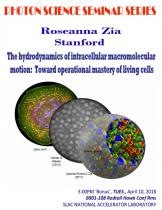Speaker: Roseanna Zia, Stanford
Program Description:
Most representations of cellular behavior rely on underlying abstractions that result in models that do not account for how molecules are organized within cells. For example, linear algebra-, differential equation-, and stochastic simulation algorithm-based models typically do not represent individual molecules or their spatial positioning and motion. For many questions in biology and medicine these simpler and abstracted models have been sufficient. However, it is becoming apparent that there are fundamental gaps in our physical understanding of cells that cannot be easily resolved. Here we discuss our progress in adapting and advancing modeling and simulation tools developed for spherically confined colloidal suspensions, for use in studying cellular systems, so that biomolecules and their interactions can be represented individually and explicitly. By developing a more robust and fundamentally well-grounded physics model for how macromolecules interact within cells we can contribute to a more physically complete representation of living matter. A primary challenge in the development of models for such confined systems is the accurate and efficient representation of many-body hydrodynamic interactions. To accurately model spherically confined colloids, we developed new hydrodynamic mobility functions and implemented them in a Stokesian dynamics framework. The method fully accounts for all many-body far-field interactions and near-field interactions both between the particles themselves and between particles and the enclosing cavity. Utilizing this model, we studied short- and long-time self-diffusion at equilibrium. We find that confinement produces qualitative changes in transport behavior, such as a position dependent and anisotropic short-time self-diffusivity and anisotropic long-time transport behavior, as well as on particle entrainment. Connections to underlying structure are made, and consequences for cellular behavior are discussed.





